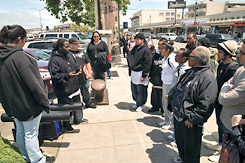How to Design Assessments for Project Learning
Creating high expectations and ensuring academic markers for at-risk students.
This how-to article accompanies the feature "Diplomas for (Would-Be) Dropouts: Project Learning Serves the Most At-Risk Students."

Assessing student learning during and at the end of complex projects can be tough, even at a school like San Francisco's Downtown High School, with its many thoughtful educators and supportive administration. Teacher Catherine Salvin says that Downtown's staff focused recently on assessment to create common high expectations and ensure academic markers for their at-risk students.
"It's our job to make sure they're really getting an education," Salvin says. "Before we send them out into the world, even if they don't plan to go to college, we want to know they've mastered a certain set of skills." Salvin and her peers are working to build meaningful assessments at all levels of the school.
Create Stepping-Stones
Within the individual thematic projects, many of Downtown's teachers create assessment stepping-stones. In their multimedia project "So You Think You're Ready for Hollywood?" teachers Eunice Nuval and Kyle Beckham required students to master several academic tasks before moving into media production.
With the end goal of making a film, students conducted research on a system of oppression (xenophobia, sexism, and so on) and wrote a paper that their teachers graded based on a rubric. They studied The Screenwriter's Bible, by David Trottier, and wrote monologues they incorporated into individual screenplays based on their research. Peers assessed their work, too. In groups of ten, students selected one screenplay to turn into a film and took on tasks (working with acting coaches, running production teams, learning Apple Final Cut Pro software) to produce it. "Making the film and acting are the carrots" for completing high-quality academic work, says Nuval.
Let Students Teach
Twice a year, Downtown students teach peers and community members about their projects and semester-long learning during exhibition days. This past June, the Starstruck and Get Out & Learn (GO&L) students held their exhibitions off campus; Starstruck students replicated the solar system at Fisherman's Wharf and GO&L students described the process of making their skiff at Aquatic Park.
At school, Still Life/Real Life students presented multimedia oral history and photo-essay projects. In the Wilderness Arts and Literacy Collaborative pathway, Salvin and team teacher Sherry Bass pushed students to make their exhibitions interactive: After a unit focusing on northern California geology, immigration, and migration, students completed projects integrating painting and poetry with history and geology. For exhibition, the students created an art gallery and became docents, describing each other's artwork, and held a poetry reading.
Salvin believes exhibitions really show what students have learned because they become instructors during these events. But each teacher at Downtown evaluates student exhibitions differently. Though all teachers review exhibition evaluations filled out by visitors with their classes, some invest more time assessing student work and presentations. Others rely on a four-point scale to rate students on the quality of their product, presentation, and participation.
Use Schoolwide Assessments
Downtown's Literacy Committee has initiated schoolwide assessments. After piloting the program in a few pathways, all the teachers now assign a novel and a response-to-literature essay related to their theme, and score these essays on a standardized rubric. Before launching this assignment schoolwide, Downtown used weekly meeting time for professional development around vocabulary and Bloom's Taxonomy (so all teachers would be taking literature discussions to high levels), introduced the essay rubric, and repeatedly anchored essays together so there was a common understanding of what the scores mean. Last spring, the school piloted a similar program with reading strategies and a rubric; it will be added to Downtown's schoolwide initiatives this year.
Look Inward
Assessment doesn't end with students. Last spring, Downtown launched a project-portfolio system for teachers. For each project, teachers gather foundation pieces (project curriculum, syllabi, and so on), samples of varying levels of academic work, and examples of application of schoolwide rubrics, as well as typical student evaluations and project products.
The school leadership team led professional-development sessions and had teachers share their work. The sessions began with a preportfolio activity in which teacher pairs visited each other's classrooms and gave feedback about content integration and academic rigor. In their portfolios, Salvin says, "teachers must have evidence of their students satisfying our critical academic skills, which are the performance standards of project-based learning at the school and the schoolwide initiatives."